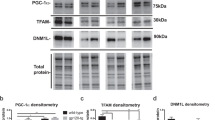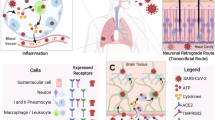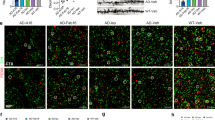Abstract
The human immunodeficiency virus-1 (HIV-1) envelope protein gp120 is the major contributor to the pathogenesis of HIV-associated neurocognitive disorder (HAND). Neuroinflammation plays a pivotal role in gp120-induced neuropathology, but how gp120 triggers neuroinflammatory processes and subsequent neuronal death remains unknown. Here, we provide evidence that NLRP3 is required for gp120-induced neuroinflammation and neuropathy. Our results showed that gp120-induced NLRP3-dependent pyroptosis and IL-1β production in microglia. Inhibition of microglial NLRP3 inflammasome activation alleviated gp120-mediated neuroinflammatory factor release and neuronal injury. Importantly, we showed that chronic administration of MCC950, a novel selective NLRP3 inhibitor, to gp120 transgenic mice not only attenuated neuroinflammation and neuronal death but also promoted neuronal regeneration and restored the impaired neurocognitive function. In conclusion, our data revealed that the NLRP3 inflammasome is important for gp120-induced neuroinflammation and neuropathology and suggest that NLRP3 is a potential novel target for the treatment of HAND.
This is a preview of subscription content, access via your institution
Access options
Subscribe to this journal
Receive 12 digital issues and online access to articles
$119.00 per year
only $9.92 per issue
Buy this article
- Purchase on Springer Link
- Instant access to full article PDF
Prices may be subject to local taxes which are calculated during checkout










Similar content being viewed by others
References
Saylor, D. et al. HIV-associated neurocognitive disorder—pathogenesis and prospects for treatment. Nat. Rev. Neurol. 12, 234–248 (2016).
Clifford, D. B. & Ances, B. M. HIV-associated neurocognitive disorder. Lancet Infect. Dis. 13, 976–986 (2013).
Eggers, C. et al. HIV-1-associated neurocognitive disorder: epidemiology, pathogenesis, diagnosis, and treatment. J. Neurol. 264, 1715–1727 (2017).
Brenneman, D. E. et al. Neuronal cell killing by the envelope protein of HIV and its prevention by vasoactive intestinal peptide. Nature 335, 639–642 (1988).
Toggas, S. M. et al. Central nervous system damage produced by expression of the HIV-1 coat protein gp120 in transgenic mice. Nature 367, 188–193 (1994).
Kaul, M., Garden, G. A. & Lipton, S. A. Pathways to neuronal injury and apoptosis in HIV-associated dementia. Nature 410, 988–994 (2001).
Capo-Velez, C. M., Morales-Vargas, B., Garcia-Gonzalez, A. & Grajales-Reyes, J. G. The alpha7-nicotinic receptor contributes to gp120-induced neurotoxicity: implications in HIV-associated neurocognitive disorders. Sci. Rep. 8, 1829 (2018).
D’Hooge, R., Franck, F., Mucke, L. & De Deyn, P. P. Age-related behavioural deficits in transgenic mice expressing the HIV-1 coat protein gp120. Eur. J. Neurosci. 11, 4398–gp4402 (1999).
Gonzalez-Scarano, F. & Martin-Garcia, J. The neuropathogenesis of AIDS. Nat. Rev. Immunol. 5, 69–81 (2005).
Chen, N. C., Partridge, A. T., Sell, C., Torres, C. & Martin-Garcia, J. Fate of microglia during HIV-1 infection: from activation to senescence? Glia 65, 431–446 (2017).
Heneka, M. T., McManus, R. M. & Latz, E. Inflammasome signalling in brain function and neurodegenerative disease. Nat. Rev. Neurosci. 19, 610–621 (2018).
Mangan, M. S. J. et al. Targeting the NLRP3 inflammasome in inflammatory diseases. Nat. Rev. Drug Disco. 17, 588–606 (2018).
Liu, X. et al. Inflammasome-activated gasdermin D causes pyroptosis by forming membrane pores. Nature 535, 153–158 (2016).
Song, L., Pei, L., Yao, S., Wu, Y. & Shang, Y. NLRP3 inflammasome in neurological diseases, from functions to therapies. Front Cell Neurosci. 11, 63 (2017).
Allan, S. M., Tyrrell, P. J. & Rothwell, N. J. Interleukin-1 and neuronal injury. Nat. Rev. Immunol. 5, 629–640 (2005).
Heneka, M. T. et al. NLRP3 is activated in Alzheimer’s disease and contributes to pathology in APP/PS1 mice. Nature 493, 674–678 (2013).
Gordon, R. & Albornoz, E. A. Inflammasome inhibition prevents alpha-synuclein pathology and dopaminergic neurodegeneration in mice. Sci. Transl. Med 10, eaah4066 (2018).
Walsh, J. G. et al. Rapid inflammasome activation in microglia contributes to brain disease in HIV/AIDS. Retrovirology 11, 35 (2014).
Kaul, M. & Lipton, S. A. Mechanisms of neuronal injury and death in HIV-1 associated dementia. Curr. HIV Res. 4, 307–318 (2006).
Michael, N. L. & Moore, J. P. HIV-1 entry inhibitors: evading the issue. Nat. Med. 5, 740–742 (1999).
Maung, R. et al. CCR5 knockout prevents neuronal injury and behavioral impairment induced in a transgenic mouse model by a CXCR4-using HIV-1 glycoprotein 120. J. Immunol. 193, 1895–1910 (2014).
Sun, N.-N. et al. Mir-21 mediates the inhibitory effect of Ang (1–7) on AngII-induced NLRP3 inflammasome activation by targeting Spry1 in lung fibroblasts. Sci. Rep. 7, 14369 (2017).
Doitsh, G. et al. Cell death by pyroptosis drives CD4 T-cell depletion in HIV-1 infection. Nature 505, 509–514 (2014).
Ahmad, F. et al. Evidence of inflammasome activation and formation of monocyte-derived ASC specks in HIV-1 positive patients. Aids 32, 299–307 (2018).
Coll, R. C. et al. A small-molecule inhibitor of the NLRP3 inflammasome for the treatment of inflammatory diseases. Nat. Med. 21, 248–255 (2015).
Afonina, I. S., Zhong, Z., Karin, M. & Beyaert, R. Limiting inflammation-the negative regulation of NF-kappaB and the NLRP3 inflammasome. Nat. Immunol. 18, 861–869 (2017).
Liu, J., Xu, C., Chen, L., Xu, P. & Xiong, H. Involvement of Kv1.3 and p38 MAPK signaling in HIV-1 glycoprotein 120-induced microglia neurotoxicity. Cell Death Dis. 3, e254 (2012).
Xu, C. et al. HIV-1 gp120 enhances outward potassium current via CXCR4 and cAMP-dependent protein kinase A signaling in cultured rat microglia. Glia 59, 997–1007 (2011).
Ogishi, M. & Yotsuyanagi, H. Prediction of HIV-associated neurocognitive disorder (HAND) from three genetic features of envelope gp120 glycoprotein. Retrovirology 15, 12 (2018).
Barak, O. et al. Involvement of brain cytokines in the neurobehavioral disturbances induced by HIV-1 glycoprotein120. Brain Res. 933, 98–108 (2002).
Thaney, V. E. et al. Transgenic mice expressing HIV-1 envelope protein gp120 in the brain as an animal model in neuroAIDS research. J. Neurovirol. 24, 156–167 (2018).
Ransohoff, R. M. A polarizing question: do M1 and M2 microglia exist? Nat. Neurosci. 19, 987–991 (2016).
Andersen, I. L., Boe, K. E., Foerevik, G., Janczak, A. M. & Bakken, M. Behavioural evaluation of methods for assessing fear responses in weaned pigs. Appl Anim. Behav. Sci. 69, 227–240 (2000).
Baroja-Mazo, A. et al. The NLRP3 inflammasome is released as a particulate danger signal that amplifies the inflammatory response. Nat. Immunol. 15, 738–748 (2014).
Chivero, E. T., Guo, M. L. & Periyasamy, P. HIV-1 Tat primes and activates microglial NLRP3 inflammasome-mediated neuroinflammation. J. Neurosci. 37, 3599–3609 (2017).
Ichinohe, T., Pang, I. K. & Iwasaki, A. Influenza virus activates inflammasomes via its intracellular M2 ion channel. Nat. Immunol. 11, 404–410 (2010).
Hafner-Bratkovic, I., Bencina, M., Fitzgerald, K. A., Golenbock, D. & Jerala, R. NLRP3 inflammasome activation in macrophage cell lines by prion protein fibrils as the source of IL-1beta and neuronal toxicity. Cell Mol. Life Sci. 69, 4215–4228 (2012).
Negash, A. A. et al. IL-1beta production through the NLRP3 inflammasome by hepatic macrophages links hepatitis C virus infection with liver inflammation and disease. PLoS Pathog. 9, e1003330 (2013).
Chandy, K. G. & Norton, R. S. Peptide blockers of Kv1.3 channels in T cells as therapeutics for autoimmune disease. Curr. Opin. Chem. Biol. 38, 97–107 (2017).
Chiang, E. Y. et al. Potassium channels Kv1.3 and KCa3.1 cooperatively and compensatorily regulate antigen-specific memory T cell functions. Nat. Commun. 8, 14644 (2017).
Maezawa, I. et al. Kv1.3 inhibition as a potential microglia-targeted therapy for Alzheimer’s disease: preclinical proof of concept. Brain 141, 596–612 (2018).
Upadhyay, S. K. et al. Selective Kv1.3 channel blocker as therapeutic for obesity and insulin resistance. Proc. Natl Acad. Sci. USA 110, E2239–E2248 (2013).
Di Lucente, J., Nguyen, H. M. & Wulff, H. The voltage-gated potassium channel Kv1.3 is required for microglial pro-inflammatory activation in vivo. Glia 66, 1881–1895 (2018).
Liu, X. & Quan, N. Microglia and CNS Interleukin-1: Beyond Immunological Concepts. Front Neurol. 9, 8 (2018).
Corasaniti, M. T. et al. 17beta-estradiol reduces neuronal apoptosis induced by HIV-1 gp120 in the neocortex of rat. Neurotoxicology 26, 893–903 (2005).
Zhou, C. et al. Interleukin-1beta downregulates the L-type Ca2 + channel activity by depressing the expression of channel protein in cortical neurons. J. Cell Physiol. 206, 799–806 (2006).
Yu, J. et al. IL-1beta stimulates brain-derived neurotrophic factor production in eutopic endometriosis stromal cell cultures: a model for cytokine regulation of neuroangiogenesis. Am. J. Pathol. 188, 2281–2292 (2018).
Corasaniti, M. T. et al. Evidence that increases of mitochondrial immunoreactive IL-1beta by HIV-1gp120 implicate in situ cleavage of pro-IL-1beta in the neocortex of rat. J. Neurochem. 78, 611–618 (2001).
Russo, R. et al. Evidence implicating matrix metalloproteinases in the mechanism underlying accumulation of IL-1beta and neuronal apoptosis in the neocortex of HIV/gp120-exposed rats. Int Rev. Neurobiol. 82, 407–421 (2007).
Lipton, S. A. & Gendelman, H. E. Seminars in medicine of the Beth Israel Hospital, Boston. Dementia associated with the acquired immunodeficiency syndrome. N. Engl. J. Med. 332, 934–940 (1995).
Block, M. L., Zecca, L. & Hong, J. S. Microglia-mediated neurotoxicity: uncovering the molecular mechanisms. Nat. Rev. Neurosci. 8, 57–69 (2007).
Valderrama, J. A., Riestra, A. M., Gao, N. J. & LaRock, C. N. Group A streptococcal M protein activates the NLRP3 inflammasome. Nat. Microbiol. 2, 1425–1434 (2017).
Ashraf, T. et al. Role of anti-inflammatory compounds in human immunodeficiency virus-1 glycoprotein120-mediated brain inflammation. J. Neuroinflamm. 11, 91 (2014).
Bachis, A., Cruz, M. I. & Mocchetti, I. M‐tropic HIV envelope protein gp120 exhibits a different neuropathological profile than T‐tropic gp120 in rat striatum. Eur. J. Neurosci. 32, 570–578 (2010).
Wang, Y., Liao, J., Tang, S. J., Shu, J. & Zhang, W. HIV-1gp120 upregulates brain-derived neurotrophic factor (BDNF) expression in BV2 cells via the Wnt/β-catenin signaling pathway. J. Mol. Neurosci. 62, 199–208 (2017).
Luo, W., Fang, W., Li, S. & Yao, K. Aberrant expression of nuclear vimentin and related epithelial–mesenchymal transition markers in nasopharyngeal carcinoma. Int. J. Cancer 131, 1863–1873 (2012).
Huang, S.-H. et al. Vimentin, a Novel NF-κB regulator, is required for meningitic Escherichia coli K1-induced pathogen invasion and PMN transmigration across the blood-brain barrier. PloS One 11, e0162641 (2016).
Dos Santos, G. et al. Vimentin regulates activation of the NLRP3 inflammasome. Nat. Commun. 6, 6574 (2015).
Hol, E. M. & Pekny, M. Glial fibrillary acidic protein (GFAP) and the astrocyte intermediate filament system in diseases of the central nervous system. Curr. Opin. Cell Biol. 32, 121–130 (2015).
El-Barbary, A. M., Kassem, E. M., El-Sergany, M. A., SALWA, A. & Eltomey, M. A. Association of anti-modified citrullinated vimentin with subclinical atherosclerosis in early rheumatoid arthritis compared with anti-cyclic citrullinated peptide. J. Rheumatol. 38, 828–834 (2011).
Thomas, E. K. et al. Anti-idiotypic antibody to the V3 domain of gp120 binds to vimentin: a possible role of intermediate filaments in the early steps of HIV-1 infection cycle. Viral Immunol. 9, 73–87 (1996).
Noda, H., Takeuchi, H., Mizuno, T. & Suzumura, A. Fingolimod phosphate promotes the neuroprotective effects of microglia. J. Neuroimmunol. 256, 13–18 (2013).
Meeker, R. B., Poulton, W., Clary, G., Schriver, M. & Longo, F. M. Novel p75 neurotrophin receptor ligand stabilizes neuronal calcium, preserves mitochondrial movement and protects against HIV associated neuropathogenesis. Exp. Neurol. 275, 182–198 (2016).
Dreyer, E. B., Kaiser, P. K., Offermann, J. T. & Lipton, S. A. HIV-1 coat protein neurotoxicity prevented by calcium channel antagonists. Science 248, 364–367 (1990).
Ashkenazi, A. et al. Polyglutamine tracts regulate beclin 1-dependent autophagy. Nature 545, 108–111 (2017).
Moss, P. J. et al. Macrophage–sensory neuronal interaction in HIV-1 gp120-induced neurotoxicity. Br. J. Anaesth. 114, 499–508 (2014).
Keswani, S. C. et al. Schwann cell chemokine receptors mediate HIV-1 gp120 toxicity to sensory neurons. Ann. Neurol. 54, 287–296 (2003).
Higgins, S., Lee, J. S., Ha, L. & Lim, J. Y. Inducing neurite outgrowth by mechanical cell stretch. BioResearch Open Access 2, 212–216 (2013).
Acknowledgements
This project was financially supported by the Key Program of the Natural Science Foundation of Guangdong, China (No. 2017B030311017), the National Natural Science Foundation of China (No. 81370740), the Program of the Natural Science Foundation of Guangdong, China (No. 2018A030313845), and the China Postdoctoral Science Foundation (No. 2018M633076).
Author information
Authors and Affiliations
Contributions
S.H., H.C., E.M., X.H., W.Y., and L.W. conceived and designed the experiments. M.E. and S.H. contributed reagents/materials/analysis tools. X.H., W.Y., Q.Z., Z.Z., Yi W., L.Q.L., L.T.L., Yu W., Z.G., J.G., H.Z., Y.L., S.Y., and T.H. performed the experiments and acquired and analyzed the data. X.H., W.Y., J.G., Q.Z., and Z.Z. prepared the figures and L.W., E.M., S.H., and H.C. helped revise them. X.H., S.H., H.C., W.Y., J.G., and L.W. drafted the paper, and S.H., X.H., E.M., H.C., W.Y., B.Z., L.L. and Yi W. revised it. All authors read and approved the final paper.
Corresponding authors
Ethics declarations
Competing interests
The authors declare no competing interests.
Supplementary information
Rights and permissions
About this article
Cite this article
He, X., Yang, W., Zeng, Z. et al. NLRP3-dependent pyroptosis is required for HIV-1 gp120-induced neuropathology. Cell Mol Immunol 17, 283–299 (2020). https://doi.org/10.1038/s41423-019-0260-y
Received:
Accepted:
Published:
Issue Date:
DOI: https://doi.org/10.1038/s41423-019-0260-y
Keywords
This article is cited by
-
Focusing on mitochondria in the brain: from biology to therapeutics
Translational Neurodegeneration (2024)
-
gp120-derived amyloidogenic peptides form amyloid fibrils that increase HIV-1 infectivity
Cellular & Molecular Immunology (2024)
-
Activation of NLRP3 inflammasome in a rat model of cerebral small vessel disease
Experimental Brain Research (2024)
-
Tricyclic antidepressants induce liver inflammation by targeting NLRP3 inflammasome activation
Cell Communication and Signaling (2023)
-
CEBPα/miR-101b-3p promotes meningoencephalitis in mice infected with Angiostrongylus cantonensis by promoting microglial pyroptosis
Cell Communication and Signaling (2023)



